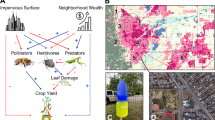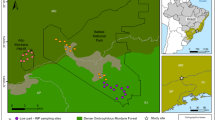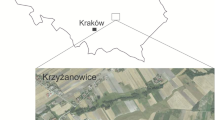Abstract
Woodlice are top consumers of a three-trophic system (soil, leaf litter, woodlice), and they are closely related to pollutant absorbing surfaces such as soil, leaf litter, and organic matter. We studied the effects of urbanization on trace element concentrations and fluctuating asymmetry of Armadillidium vulgare (Crustacea: Isopoda) individuals in and around Debrecen city, Hungary. Along an urbanization gradient (urban, suburban, and rural areas), trace element concentrations (Ba, Cu, Fe, Mn, Pb, and Zn) of woodlice and bioconcentration factor (BCF) were analyzed. Asymmetry was also measured in metric traits of woodlice: the length of three segments of antennae, the body length, and the width of the 3rd segment of pereon. We found significant differences in Ba and Cu concentration of A. vulgare individuals along the urbanization gradient. The highest Cu concentration was found in woodlice from the urban area and the highest Ba concentration was found in the individuals from the rural area. The Ba concentration was higher in females than in males. The BCF values of Cu indicated that A. vulgare accumulated this element from soil and leaf litter. There was no significant difference in symmetry of the bilateral traits of woodlice along the urbanization gradient based on FA levels. Our results showed that the urbanization had remarkable effect on the Ba and Cu concentration of woodlice which were originated from traffic pollution. At the same time, the anthropogenic activities did not affect the symmetry of the tested traits of A. vulgare individuals.



Similar content being viewed by others
References
Purchart L, Kula E, Suchomel J (2010) The reaction of ground beetle (Coleoptera: Carabidae) assemblages to a contaminated mining site in Central Europe. Com Ecol 11:242–249
Gal J, Markiewicz-Patkowska J, Hursthouse A, Tatner P (2008) Metal uptake by woodlice in urban soils. Ecotoxicol Environ Saf 69:139–149
Cachada A, Dias AC, Pato P, Mieiro C, Rocha-Santos T, Pereira ME, Ferreira da Silva E, Duarte AC (2013) Major inputs and mobility of potentially toxic elements contamination in urban areas. Environ Monit Assess 185:279–294
Pacyna JM (1984) Estimation of the atmospheric emissions of trace elements from anthropogenic sources in Europe. Atmos Environ 18:41–50
Monaci F, Bargagli R (1997) Barium and other trace metals as indicators of vehicle emissions. Water Air Soil Pollut 100:89–98
Simon E, Harangi S, Baranyai E, Braun M, Fábián I, Sz M, Nagy L, Tóthmérész B (2015) Distribution of toxic elements between biotic and abiotic components of terrestrial ecosystem along an urbanization gradient: soil, leaf litter and ground beetles. Ecol Indic 60:258–264
Cortet J, Gomot-De Vauflery A, Poinsot-Balaguer N, Gomot L, Texier C, Daniel C (1999) The use of invertebrate soil fauna in monitoring pollutant effects. Eur J Soil Biol 35:115–134
Lens L, Van Dongen S, Salit K, Matthysen E (2002) Fluctuating asymmetry as an indicator of fitness: can we bridge the gap between the studies? Biol Rev 7:27–38
Vilisics F, Sólymos P, Hornung E (2005) Measuring fluctuating asymmetry of the terrestrial isopod Trachelipus rathkii (Crustacea: Isopoda, Oniscidea). Eur J Soil Biol 41:85–90 woodlice in urban soils. Ecotox Environ Safe 69:136–149
Zöld B, Wittmann KJ (2003) Effects of sampling, preparation and defection on metal concentrations in selected invertebrates at urban sites. Chemosphere 52:1095–1110
Magura T, Lövei GL, Tóthmérész B (2010) Does urbanization decrease diversity in ground beetle (Carabidae) assemblages? Glob Ecol Biogeogr 19:16–26
Hopkin SP, Hardisty GN, Martin MH (1986) The woodlouse Porcellio scaber as a ‘biological indicator’ of zinc, cadmium, lead and copper pollution. Environ Pollut 11:271–290
Hopkin SP, Jones DT, Dietrich D (1993) The isopod Porcellio scaber as a monitor of the bioavailability of metals in terrestrial ecosystems: towards a global ‘woodlouse watch’ scheme. Sci Total Environ 134:357–365
Dallinger R, Berger B, Birkel S (1992) Terrestrial isopods: useful biological indicators of urban metal pollution. Oecologia 89:32–41
Heikens A, Peijnenburg WJGM, Hendricks AJ (2001) Bioaccumulation of heavy metals in terrestrial invertebrates. Environ Pollut 113:385–393
Zidar P, Drobne D, Strus J, Blejec A (2003) Intake and assimilation of zinc, copper, and cadmium in the terrestrial Isopod Porcellio scaber Latr. (Crustacea, Isopoda). Bull Environ Contam Toxicol 70:1028–1035
Dallinger R (1993) Strategies of metal detoxification in terrestrial invertebrates. In: Dallinger R, Rainbow PS (eds) Ecotoxicology of metals in invertebrates. Lewis Publishers, Boca Raton, pp 245–289
Witzel B (2000) The influence of zinc on the uptake and loss of cadmium and lead in the woodlouse, Porcellio scaber (Isopoda, Oniscidea). Ecotoxicol Environ Saf 47:43–53
Nannoni F, Mazzero R, Protano G, Santolini R (2015) Bioaccumulation of heavy elements by Armadillidium vulgare (Crustacea, Isopoda) exposed to fallout of a municipal solid waste landfill. Ecol Indic 49:24–31
Prosi F, Dallinger R (1988) Heavy metals in the terrestrial isopod Porcellio scaber Latreille. I. Histochemical and ultrastructural characterization of metal containing lysosomes. Cell Biol Toxicol 4:81–96
Dallinger R, Prosi F (1988) Heavy metals in the terrestrial isopod Porcellio scaber Latreille. II. Subcellular fractionation of metal-accumulating lysosomes from hepatopancreas. Cell Biol Toxicol 4:97–109
Donker MH, Koevoets P, Verkleij JAC, Van Straalen NM (1990) Metal binding compounds in hepatopancreas and haemolymph of Porcellio scaber (isopoda) from contaminated and reference areas. Comp Biochem Physiol Part C: Comp Pharmacol 97:119–126
Jones DT, Hopkin SP (1998) Reduced survival and body size in terrestrial isopod Porcellio scaber from a metal-polluted environment. Environ Pollut 90:215–233
Hopkin S (1989) Ecophysiology of metals in terrestrial invertebrates. Elsevier Applied Science, Barking 366 pp
Palmer AR, Strobeck C (1992) Fluctuating asymmetry as a measure of developmental stability: implications of non-normal distributions and power of statistical tests. Acta Zool Fenn 191:57–72
Peters EL, Jagoe CH, Bell TJ (2001) Effects of accumulation of hazardous metals on terrestrial isopod (Armadillidium vulgare) in urban environments. Abstracts of the 86. Annual meeting of the Ecological Society of America (pp 329). Madison, WI
Godet JP, Demuynck S, Waterlot C, Lemière S, Souty-Grosset C, Scheifler R, Douay F, Leprêtre A, Pruvot C (2011) Growth and metal accumulation in Porcellio scaber exposed to poplar litter from Cd-, Pb-, and Zn-contaminated sites. Ecotoxicol Environ Saf 74:451–458
Farkas S, Vilisics F (2013) Magyarország szárazföldi ászkarák faunájának határozója (Isopoda: Oniscidea). Nat Somogy 23:89–124
Magura T, Tóthmérész B, Elek Z (2004) Effects of leaf-litter addition on carabid beetles in a nonnative Norway spruce planation. Acta Zool Acad Sci Hung 50:9–23
Braun M, Simon E, Fábián I, Tóthmérész B (2009) The effects of ethylene glycol and ethanol on the body mass and elemental composition of insects collected with pitfall traps. Chemosphere 77:1447–1452
Braun M, Simon E, Fábián I, Tóthmérész B (2012) Elemental analysis of pitfall-trapped insect samples: effect of ethylene glycol grades. Entomol Exp Appl 143:89–94
Simon E, Braun M, Vidic A, Bogyó D, Fábián I, Tóthmérész B (2011) Air pollution assessment based on elemental concentration of leaves tissue and foliage dust along an urbanization gradient in Vienna. Environ Pollut 159:1229–1233
Simon E, Baranyai E, Braun M, Fábián I, Tóthmérész B (2013) Elemental concentration in mealworm beetle (Tenebrio molitor L.) during metamorphosis. Biol Trace Elem Res 154:81–87
Simon E, Kis O, Jakab T, Kolozsvári I, Málnás K, Harangi S, Baranyai E, Miskolczi M, Tóthmérész B, Gy D (2017) Assessment of contamination based on trace element concentration of dragonfly larvae in the Upper Tisza Region. Ecotoxicol Environ Saf 13:55–61
Garg R, Smith CJ (2014) Predicting the bioconcentration factor of highly hydrophobic organic chemicals. Food Chem Toxicol 69:252–259
Ivanciuc T, Ivanciuc O, Klein DJ (2006) Modeling the bioconcentration factors and bioaccumulation factors of polychlorinated biphenyls with posetic quantitative super-structure/activity relationships (QSSAR). Mol Divers 10:133–145
Van Valen L (1962) A study of fluctuating asymmetry. Evolution 16(2):125–142 Published by: Society for the Study of Evolution
Palmer AR (1996) Fluctuating asymmetry analyses: a primer. In: Markow TA (ed) Developmental instability: its origins and evolutionary implications. Kluwer, Netherlands, pp 335–364
Van Straalen NM, Butovsky RO, Pokarzhevskii AD, Zaitsev AS, Verhoef SC (2001) Metal concentrations in soils and invertebrates in the vicinity of a metallurgical factory near Tula (Russia). Pedobiologia 4:451–466
Drobne D, Hopkin SP (1995) The toxicity of zinc to terrestrial isopods in a “standard” laboratory test. Ecotoxicol Environ Saf 31:1–6
Godet JP, Demuynck S, Waterlot C, Lemière S, Souty-Grosset C, Douay F, Leprêtre A, Pruvot C (2012) Fluctuating asymmetry analysis on Porcellio scaber (Crustacea, Isopoda) populations living under metals-contaminated woody habitats. Ecol Indic 23:130–139
Odendaal JP, Reinecke AJ (1998) The sublethal effects and accumulation of cadmium in the terrestrial Isopod Porcellio laevis Latr. (Crustacea, Isopoda). Department of Zoology, University of Stellenbosch, Private Bag X1, Matieland 7602, South Africa
Simon E, Baranyai E, Braun M, Cserháti C, Fábián I, Tóthmérész B (2014) Elemental concentrations in deposited dust on leaves along an urbanization gradient. Sci Total Environ 490:514–520
Kertész Z, Szoboszlai Z, Dobos E, Borbély-Kiss I (2008) Characterization of urban aerosol sources in Debrecen, Hungary. AGD Lands Environ 1:57–67
Lowenthal DH, Zielinska B, Chow JC, Watson JG, Gautam M, Ferguson DH, Neuroth GR, Stevens KD (1994) Characterization of heavy-duty diesel vehicle emissions. Atmos Environ 28:731–743
Hulskotte JH, van der Gon HA, Visschedijk AJ, Schaap M (2007) Brake wear from vehicles as an important source of diffuse copper pollution. Water Sci Technol 56:223–231
Kozlov MV, Haukioja E, Bakhtiarov AV, Stroganov DN, Zimina SN (2000) Root versus canopy uptake of heavy metals by birch in an industrially polluted area: contrasting behaviour of nickel and copper. Environ Pollut 107:413–420
Sardans J, Peñuelas J (2005) Trace element accumulation in the moss Hypnum cupressiforme Hedw. and the trees Quercus ilex L. and Pinus halepensis Mill. in Catalonia. Chemosphere 60:1293–1307
Hassal LM, Turner JG, Rands MRW (1978) Effects of terrestrial isopods on the decomposition of woodland leaf litter. Oecologia 72:597–604
Vijver MG, Vink JPM, Jager T, Van Straalen NM, Wolterbeek HT, Van Gestel CAM (2006) Kinetics of Zn and Cd accumulation in the isopod Porcellio scaber exposed to contaminated soil and/or food. Soil Biol Biochem 38:1554–1563
Jelaska LS, Blanusa M, Durbesic P, Jelaska D (2007) Heavy metal concentrations in ground beetles, leaf litter, and soil of a forest ecosystem. Ecotoxicol Environ Saf 66:74–81
Butovsky RO (2011) Heavy metals in carabids (Coleoptera: Carabidae). In: Kotze DJ, Assmann T, Noordíjk J, Turin H, Vermeulen R (eds) Carabid beetles as bioindicators: biogeographical, ecological and environmental studies. ZooKeys 100:215–222
Witzel B (1992) Die Eignung von Porcellio scaber ¸atr. (Isopoda) zumaktiven Monitoring von Blei- und Cadmiumim missionen in anthropogenbelasteten OG kosystemen. Ph.D. thesis, Free University Berlin
Jemec A, Lester V, Drobne D (2012) The link between antioxidant enzymes catalase and glutathione S-transferase and psychological condition of a control population of terrestrial isopod (Porcelio scaber). Ecotoxicol Environ Saf 79:42–47
Polak M, Opoka R, Cartwright IL (2002) Response of fluctuating asymmetry to arsenic toxicity: support for the developmental selection hypothesis. Environ Pollut 118:19–28
Rasmuson M (2002) Fluctuating asymmetry indicator of what? Hereditas 136:177–183
Møller AP (1997) Developmental stability and fitness: a review. Am Nat 149:916–932
Funding
The study was supported by the SROP-4.2.2.B-15/1/KONV20150001 project. Research was supported by OTKA K 116639, KH 126481 and KH 126477 grants.
Author information
Authors and Affiliations
Corresponding author
Ethics declarations
Conflict of Interest
The authors declare that they have no conflicts of interest.
Rights and permissions
About this article
Cite this article
Papp, D., Simon, E., Nagy, L. et al. The Effect of Urbanization on Trace Element Concentration and Symmetry of Woodlice (Armadillidium vulgare Latreille, 1804). Biol Trace Elem Res 189, 251–258 (2019). https://doi.org/10.1007/s12011-018-1454-3
Received:
Accepted:
Published:
Issue Date:
DOI: https://doi.org/10.1007/s12011-018-1454-3




